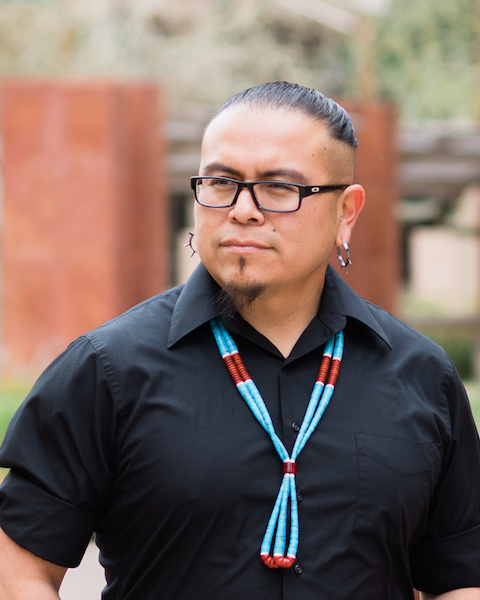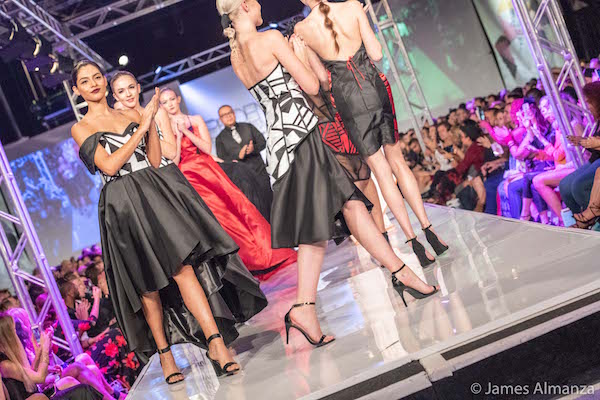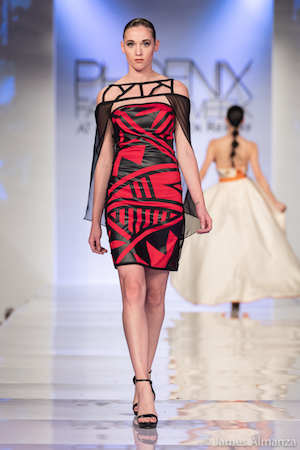
- Details
- By Rich Tupica
This is another profile in a series of Q&A profiles spotlighting established Native American business owners and emerging entrepreneurs who are working through the pandemic. Native News Online shares their life story, from how they became the person they are today to how they’re coping with the COVID-19 crisis.
Loren Aragon, CEO and designer at ACONAV, a Native-owned couture fashion brand, spent the first 18 years of his life growing up on the Acoma Pueblo reservation in New Mexico. From there, his life has gone in many directions. From science to the arts, his resume is not only stacked with accomplishments, but is as diverse as one could imagine.
Aragon, 40, chatted with Native News Online this week. Here’s what he had to say about his rise into the fabulous world of fashion. What’s the nutshell description of ACONAV’s vibe or aesthetic?
ACONAV is a celebration of the strength and empowerment of women worldwide. This celebration is expressed through positive ideas shared through fashion that tie the Acoma culture to modern style. The Acoma pottery art is the dominating influence in my work. Several collections display the distinct geometric designs/patterns that give identity to our culture here in the Southwest. In addition to these prints/textile patterns, I also make connections to the things we believe in from the natural world. Most of our beliefs lie in the ideas of the living world and its beauty, which brings goodness to the world.
Since COVID-19 has essentially shut down the economy, how has ACONAV been working through it?
We continue to focus on online sales during this challenging time, taking advantage of more social media activity to create an awareness of our existence and our message. As it turns out, we also have moved into designing a much needed protective commodity during this time. With a need for more personal protective equipment (PPE) for healthcare workers, we’ve contributed to the fight against COVID-19 by designing face masks with a designer twist.
 Models on the runway show off Aconav designs. (Courtesy photo)
Models on the runway show off Aconav designs. (Courtesy photo)
Looking forward, what does ACONAV plan to do after things start to open back up?
We will be hitting the ground running. We still have a collection on hold which was a follow up to the 2020 Couture designs. We can’t wait to debut it on a runway. Plans are still to launch a full couture collection for 2021, once this is all over. Right now, mask-making is keeping the business moving. Once we get to a manageable spot, I’ll dive into some new designs which I hope will incorporate more of my metal working talents. What's a typical day look like, pre-Covid-19, for a designer such as yourself?
It’s a balancing act when you and your small team wear many hats. In the process of a collection, the designing starts about six-to-eight months ahead of showcase time. For me, my major couture showcase happens for Phoenix Fashion Week (PHXFW) in October, so I’m usually beginning to think through what my collection will entail starting in March. It takes a lot of persistence to get the designs made among all the distractions of running the business and filling orders and taking care of social media.
Looking back, what do you recall most about your childhood?
I had a good mix of traditional and modern teachings by my grandfather, who was a traditional leader, and my mother, who was an educator. I was a nerdy kid, always into anything and everything that was art and science. My mother was my first art teacher growing up and I developed a profound interest in illustration. I also had several grandmothers who made pottery so I observed the process and learned a little over time.
 Aconav on the runway. (Courtesy photo).
Aconav on the runway. (Courtesy photo).
Before you got into fashion and design, what were you up to?
I like to say that I went from “geek to chic.” I was actually an engineer before ACONAV. I finished my degree in mechanical engineering from Arizona State University and worked in multiple engineering positions around the Phoenix area, but I always had art in my background and worked as an artist on the side. What’s the earliest roots of ACONAV? In 2008, ACONAV actually started out as a greeting card company with my wife. It was during my time as an engineer. I slowly took it further as my interests in the arts grew. I ventured into jewelry making, sculpture and then fashion design. The name was coined as a cohesion of cultures between myself, an Acoma, and my wife Valentina, who is Navajo (Dinè). We wanted a representation of both cultures in our work, as we found out that many of our beliefs stemmed from the same natural ideas.
How long was it before you launched a line?
I did my first full collection of 20 pieces in December 2014, and showcased my designs in various showcases all through 2015. The following year, I was accepted into the PHXFW designer bootcamp, which taught me all about the business of fashion. In March 2016, ACONAV became a full-time fashion brand. I was in the program for two consecutive years and competed for the title of Couture Designer of the Year. In 2017, the hard work paid off and ACONAV became the first ever Native American fashion brand to win the coveted title.
Do you recall your earliest entry into the world of fashion?
I was always around the world of fashion since I was young, but I didn’t realize it. My mother and my aunt have been seamstresses for most of their lives. I also observed a lot of it growing up, but I didn’t have a big interest in it. It wasn’t until I attended my first fashion show at Phoenix Fashion Week that the idea of doing fashion came to mind. I observed the artist that walked the runway and wondered to myself, “Why are there no Native American designers in this showcase when this is in our very own backyard, among so many tribes, in the southwest?” I took it upon myself to work at becoming a part of all that and also looked back to my mother and aunt for help in learning how to sew.
Are there any designers who’ve inspired you over the years?
My first indigenous designer influence was Virgil Ortiz. I was introduced to his work by a couple friends, and when I saw his connection with culture through fashion, I was blown away. I had the very same ideas of working my Acoma culture into my work and I saw firsthand that it was very doable. Outside of our Native communities, I instantly fell in love with the work of Alexander McQueen, the artistry and detail in his work, especially in his more structural garments, is what inspired the engineer in me to apply my technical knowledge to fashion.
More Stories Like This
American Basketball Association Announces Native ABA InitiativeFour Winds South Bend Upgrades to Class III Gaming Casino
Native News Online Wins Two Awards from Native American Journalists Association
Wahlberg Brothers Are a Big Hit at Indian Gaming Tradeshow and Convention in Las Vegas
Native Gro Offers Tribes a ‘One-Stop Shop’ for Entering the Cannabis Industry
Help us tell the stories that could save Native languages and food traditions
At a critical moment for Indian Country, Native News Online is embarking on our most ambitious reporting project yet: "Cultivating Culture," a three-year investigation into two forces shaping Native community survival—food sovereignty and language revitalization.
The devastating impact of COVID-19 accelerated the loss of Native elders and with them, irreplaceable cultural knowledge. Yet across tribal communities, innovative leaders are fighting back, reclaiming traditional food systems and breathing new life into Native languages. These aren't just cultural preservation efforts—they're powerful pathways to community health, healing, and resilience.
Our dedicated reporting team will spend three years documenting these stories through on-the-ground reporting in 18 tribal communities, producing over 200 in-depth stories, 18 podcast episodes, and multimedia content that amplifies Indigenous voices. We'll show policymakers, funders, and allies how cultural restoration directly impacts physical and mental wellness while celebrating successful models of sovereignty and self-determination.
This isn't corporate media parachuting into Indian Country for a quick story. This is sustained, relationship-based journalism by Native reporters who understand these communities. It's "Warrior Journalism"—fearless reporting that serves the 5.5 million readers who depend on us for news that mainstream media often ignores.
We need your help right now. While we've secured partial funding, we're still $450,000 short of our three-year budget. Our immediate goal is $25,000 this month to keep this critical work moving forward—funding reporter salaries, travel to remote communities, photography, and the deep reporting these stories deserve.
Every dollar directly supports Indigenous journalists telling Indigenous stories. Whether it's $5 or $50, your contribution ensures these vital narratives of resilience, innovation, and hope don't disappear into silence.
 The stakes couldn't be higher. Native languages are being lost at an alarming rate. Food insecurity plagues many tribal communities. But solutions are emerging, and these stories need to be told.
The stakes couldn't be higher. Native languages are being lost at an alarming rate. Food insecurity plagues many tribal communities. But solutions are emerging, and these stories need to be told.
Support independent Native journalism. Fund the stories that matter.
Levi Rickert (Potawatomi), Editor & Publisher
